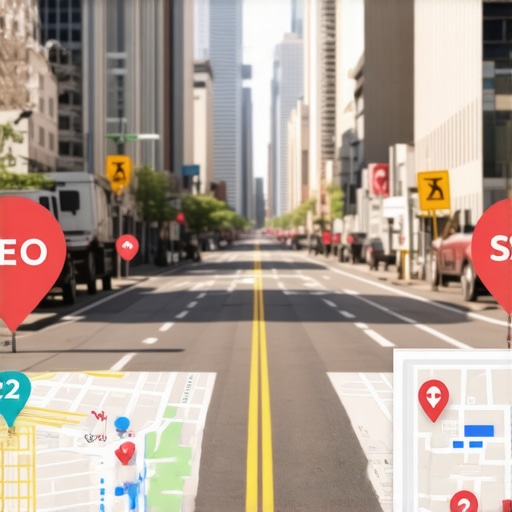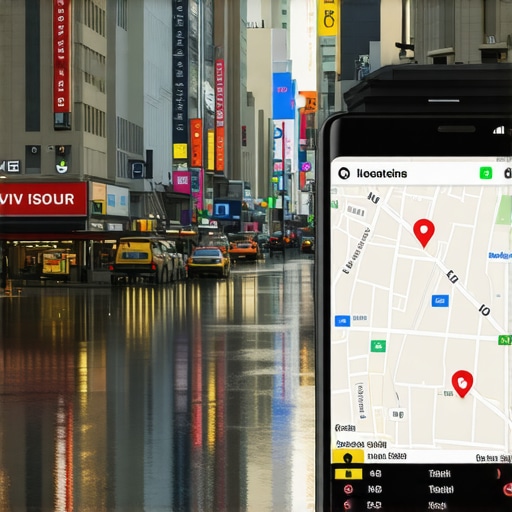Unlocking the Full Potential of Maps SEO: A Strategic Perspective for 2024
In the evolving landscape of local search, Maps SEO has transitioned from a supplementary tactic to a core component of comprehensive digital marketing strategies. For professionals seeking to dominate Google rankings in 2024, understanding the nuanced interplay between traditional SEO and specialized local optimization is paramount. This article delves into advanced, expert-level techniques that leverage the latest algorithms, semantic search behaviors, and user intent signals to elevate your Google Maps presence effectively.
Deciphering Google’s Algorithmic Evolution and Its Impact on Maps Optimization
The core challenge in 2024 is adapting to Google’s continuous algorithmic refinements, which now prioritize contextual relevance and user experience. The incorporation of machine learning models such as MUM (Multitask Unified Model) underscores the need for semantic richness in your Maps SEO approach. Expert practitioners analyze how Google correlates local intent with broader search queries, making it essential to optimize not only for keywords like “best pizza near me” but also for related semantic clusters such as “food delivery services” and “local dining experiences”.
Harnessing Structured Data and Schema Markup for Hyper-Contextual Rankings
One of the most underutilized yet potent tools in Maps SEO is the strategic deployment of structured data, particularly LocalBusiness schema. When meticulously implemented, schema markup enhances the algorithm’s understanding of your business’s category, services, and operational details. Integrating rich snippets such as menus, booking options, and customer reviews into your Google My Business profile can significantly improve visibility, especially in competitive markets.
Optimizing for Voice Search and Conversational Queries in Maps SEO
With the rise of voice-activated search, especially on mobile devices, optimizing Maps SEO for conversational queries has become an expert necessity. People now ask questions like, “Where can I find an affordable dentist open now?” Crafting content that naturally integrates long-tail, question-based keywords, and ensuring your GMB profile is equipped with detailed, up-to-date information, will help capture this traffic. Leveraging voice search optimization techniques can thus serve as a differentiator in 2024.
What are the most effective ways to leverage user-generated content to enhance local search rankings?
Expert consensus indicates that authentic reviews, photos, and Q&A interactions are critical for building credibility and relevance. Encouraging satisfied customers to leave detailed reviews, respond promptly to negative feedback, and regularly update visual content can foster a robust reputation signal to Google. Internal linking strategies—such as connecting your GMB posts to your website’s relevant pages—further amplify your local authority.
Integrating Multichannel Data for Holistic Local SEO Strategies
Top-tier Maps SEO practitioners now combine data from multiple channels—social media, review platforms, and local directories—to create a unified, authoritative presence. This multisource approach ensures consistency in NAP (Name, Address, Phone Number) data and reinforces relevance signals across platforms. Advanced tools that monitor and analyze local rank fluctuations enable ongoing optimization, ensuring your maps visibility remains resilient against algorithmic volatility.
For those interested in deepening their expertise, consulting authoritative sources such as Google’s official developer blog offers insights into algorithmic updates and recommended best practices.
As the digital landscape becomes increasingly competitive, mastering these sophisticated Maps SEO techniques will distinguish your brand and substantially improve your Google search rankings in 2024. Explore related content on Maps SEO strategies for 2024 and contribute your insights to the professional community to stay ahead in local search dominance.
Leveraging AI and Machine Learning to Elevate Maps SEO Performance
As Google continues to refine its algorithmic landscape, integrating artificial intelligence (AI) and machine learning (ML) tools into your Maps SEO strategy has become an expert-level necessity. These technologies enable a nuanced understanding of user intent, semantic clustering, and contextual relevance, allowing businesses to tailor their local SEO efforts more precisely. For instance, AI-driven keyword research can identify emerging search queries, while ML algorithms can predict ranking fluctuations, enabling proactive adjustments.
Can Predictive Analytics Transform Your Local SEO Approach?
Predictive analytics harness vast datasets—such as user behavior, review sentiment, and competitor activity—to forecast future search trends and ranking opportunities. By applying advanced analytics, local businesses can optimize their listings ahead of algorithm updates, ensuring sustained visibility. Tools like Google’s own official developer blog emphasize the importance of data-driven decision-making in Maps SEO.
The Power of Multimodal Optimization: Beyond Textual Content
Expert practitioners recognize that multimodal optimization—integrating images, videos, and voice snippets—significantly enhances local search visibility. Rich media content not only engages users but also provides additional signals for Google’s ranking algorithms. For example, high-quality photos, 360-degree virtual tours, and short videos embedded within GMB profiles can dramatically improve engagement metrics and local relevance.
How can local brands harness multimodal content to differentiate themselves in a crowded digital space?
Authentic, high-resolution visuals combined with concise, keyword-optimized descriptions create a compelling narrative that resonates with both users and search engines. Integrating user-generated content, such as customer photos and reviews, further bolsters credibility and relevance. To maximize impact, linking multimodal assets across platforms—like social media, review sites, and your website—ensures consistency and reinforces your local authority. Interested in innovative visual strategies? Explore how top Maps SEO techniques can be adapted to your business.
Utilizing Local Data Ecosystems for a Holistic SEO Framework
Building a comprehensive local SEO ecosystem involves aggregating and analyzing data from multiple sources—social media engagement, customer reviews, local directories, and even IoT devices. This multidimensional approach enables a granular understanding of local market dynamics, helping you craft hyper-targeted campaigns. For instance, real-time sentiment analysis on review platforms can inform immediate reputation management actions, maintaining your local relevance and trustworthiness.
For a deeper dive into effective local data integration, consider consulting Google’s official guidance on data-driven optimization practices.
Are you ready to transform your Maps SEO with cutting-edge technologies and holistic data strategies? Share your thoughts or ask questions below, and explore more on effective Maps SEO techniques for 2024 to stay ahead of the competition.
Harnessing Hyperlocal Data Ecosystems for Precision Targeting
In the pursuit of unrivaled visibility on Google Maps, leveraging hyperlocal data ecosystems becomes indispensable. Advanced practitioners integrate real-time data streams from IoT devices, social media check-ins, and localized sentiment analysis to refine their targeting and optimize their listings dynamically. This multidimensional data approach enables businesses to respond swiftly to emerging trends, seasonal fluctuations, and local events, ensuring their maps presence remains highly relevant and competitive.
For example, integrating data from smart city sensors that monitor foot traffic or environmental conditions can inform optimal placement and promotional strategies. Such integration not only enhances the accuracy of your local SEO efforts but also positions your brand as a proactive, community-engaged entity.
How can local businesses systematically incorporate IoT and social media data to refine their Maps SEO strategies?
By deploying advanced data analytics platforms that aggregate and analyze this information, businesses can identify patterns and opportunities that are invisible through traditional metrics. This enables hyper-targeted campaigns, personalized user experiences, and timely updates that resonate with the local audience. For further insights, consult authoritative sources like Google’s official developer blog, which discusses emerging data integration techniques for local SEO.
Semantic Search and Contextual Relevance: The Next Frontier of Maps Optimization
As Google’s algorithm becomes increasingly sophisticated, understanding semantic search and contextual relevance is paramount. Modern Maps SEO transcends keyword stuffing; it requires an in-depth grasp of user intent, local context, and the nuances of natural language processing (NLP). Incorporating semantic keywords, related entities, and contextual signals into your content and profile optimizations can substantially elevate your rankings.
For instance, optimizing your Google My Business profile with rich, context-aware descriptions that address specific local needs—such as accessibility features, community involvement, or niche services—can enhance relevance signals. Moreover, leveraging structured data to embed semantic relationships within your website and profiles further solidifies your prominence in nuanced searches.
What advanced NLP techniques can be employed to enhance local content relevance for Maps SEO?
Techniques such as entity recognition, sentiment analysis, and topic modeling enable businesses to craft highly relevant, context-rich content. Utilizing tools like BERT or GPT-4 to analyze and generate local content aligned with user intent ensures your listings are both engaging and authoritative. Consult industry-leading NLP research published by organizations like Google AI (https://ai.google/research) for cutting-edge methodologies.
Implementing Multimodal Optimization for Unmatched User Engagement
Beyond textual optimization, multimodal strategies that incorporate high-quality images, virtual tours, videos, and voice snippets dramatically enhance user engagement and local relevance. Google’s algorithms interpret these rich media signals as indicators of trustworthiness and authority, translating into higher rankings.
For example, embedding 360-degree virtual tours of your storefront or service area can attract more local interest and dwell time, positively influencing your map rankings. Similarly, integrating short, keyword-optimized videos showcasing your offerings can differentiate your listing in saturated markets.
How can local brands effectively leverage multimodal content to stand out in local search results?
By creating authentic, high-resolution visuals that tell a compelling story about your business, and embedding these across your GMB profile, website, and social channels, you reinforce your local authority. Consistent branding and optimized descriptions linking multimedia assets amplify relevance signals across platforms. For detailed strategies, explore advanced multimodal optimization techniques for 2024.
Proactive Reputation Management Through Predictive Analytics
Predictive analytics, powered by machine learning, allows businesses to forecast shifts in customer sentiment, review trends, and competitive landscape changes. By analyzing historical data, predictive models can identify potential reputational risks and opportunities, enabling preemptive action.
For instance, if sentiment analysis indicates rising dissatisfaction in specific service areas, businesses can address issues proactively before they impact rankings. Integrating these insights into your local SEO dashboard ensures continuous optimization and resilience against algorithmic volatility.
Interested in mastering predictive analytics? Google’s official developer blog provides updates on the latest ML tools and best practices for local SEO professionals.
Embracing Local AI-Driven Optimization for Hyper-Personalized User Experiences
As the landscape of Maps SEO continues to evolve, integrating artificial intelligence (AI) with local data ecosystems enables unprecedented levels of personalization. Advanced practitioners are now leveraging AI algorithms to analyze hyperlocal behavioral patterns, such as foot traffic variations, seasonal trends, and community engagement metrics, to tailor their Google Maps listings dynamically. Implementing AI-powered chatbots and virtual assistants on local business profiles can further enhance user interaction, providing instant, context-aware responses that improve engagement and conversion rates.
How does leveraging AI facilitate hyperlocal targeting and what are the best practices?
Utilizing AI models trained on extensive local datasets allows businesses to predict user intent with higher accuracy, optimize content relevance, and adapt promotional strategies in real time. For example, deploying machine learning to analyze social media check-ins and environmental sensors can inform targeted offers during peak activity periods. To stay ahead, consult authoritative sources like Google AI Research, which explores emerging AI methodologies applicable to local SEO.
Innovative Use of Geospatial Data and Predictive Analytics in Maps SEO
Harnessing geospatial analytics enables hyper-precise placement and targeting strategies. Combining satellite imagery, IoT sensor data, and real-time crowd analytics allows businesses to identify high-potential zones for visibility and service delivery. Predictive analytics, powered by ML models, forecast future demand, enabling proactive content updates and resource allocation. This multidimensional approach transforms reactive SEO into a strategic, anticipatory practice.

What are the key considerations when integrating geospatial analytics into local SEO campaigns?
Effective integration requires meticulous data validation, privacy compliance, and continuous model refinement to ensure accuracy. Employing platforms like Google’s Google Maps Platform facilitates access to high-quality geospatial data and analytics tools, fostering data-driven decision-making that enhances local relevance and competitiveness.
Deepening Semantic Search Mastery with Advanced NLP Techniques
To excel in semantic search, brands must deploy sophisticated NLP techniques such as entity recognition, context modeling, and sentiment analysis. Leveraging models like BERT or GPT-4, businesses can craft highly nuanced content that aligns with user intent and local context, elevating their relevance in complex search queries. Embedding structured semantic data within profiles and websites further amplifies this effect, positioning your business at the forefront of natural language understanding in local search.
What are the emerging NLP innovations that can redefine local content relevance?
Emerging NLP research from organizations like Google AI (https://ai.google/research) highlights breakthroughs in multi-entity recognition, zero-shot learning, and contextual embeddings, all of which can be harnessed to craft hyper-relevant, context-aware local content that resonates with sophisticated user queries.
Future-Proofing Maps SEO with Multimodal and Immersive Content Strategies
Beyond traditional visual assets, integrating augmented reality (AR), virtual tours, and interactive multimedia experiences can significantly elevate local engagement. These multimodal assets not only attract more user interactions but also serve as rich signals for Google’s ranking algorithms. For instance, virtual walkthroughs of local landmarks or 3D visualizations of service environments create immersive experiences that foster trust and authority.
How can local brands utilize immersive content to outshine competitors?
Developing high-quality, interactive media that tell a compelling local story, and embedding these assets across Google My Business, your website, and social platforms, ensures consistency and maximizes visibility. For advanced strategies, explore comprehensive multimodal optimization techniques for 2024.
Integrating Real-Time Community Data for Agile Local SEO Responses
Real-time data streams from community platforms, local news feeds, and social media enable agile adjustments to your Maps SEO strategies. By continuously monitoring sentiment shifts, event calendars, and trending topics, businesses can quickly adapt their messaging and offerings to maintain relevance and prominence in local searches. This dynamic approach transforms static listings into living, responsive entities that reflect current community realities.
What infrastructure is necessary to support real-time data-driven local SEO?
Implementing robust data pipelines, utilizing API integrations with social and local data sources, and deploying AI-driven analytics platforms are critical. Platforms like Google Cloud and specialized local SEO tools provide the necessary infrastructure to process and act upon real-time insights, ensuring your local presence remains adaptive and competitive.
Conclusion: Embrace the Future of Maps SEO with Multi-Layered Strategies
In the rapidly advancing world of local search, only those who adopt a multi-layered, technologically sophisticated approach will sustain dominance. Combining AI, geospatial analytics, semantic NLP, immersive multimedia, and real-time data integration creates a comprehensive, future-proof Maps SEO strategy. Dive deeper into these cutting-edge techniques by consulting industry leaders and authoritative sources like Google’s official blog, and start transforming your local search presence today. Elevate your expertise and secure your competitive edge in 2024 and beyond!
Expert Insights & Advanced Considerations
1. Integration of AI for Hyper-Localization
Leading practitioners leverage AI models trained on hyperlocal datasets to predict user intent and tailor listings dynamically, ensuring relevance and engagement.
2. Emphasis on Multimodal Content
Incorporating immersive virtual tours, high-quality images, and videos significantly boosts user interaction and signals trustworthiness to Google’s algorithms.
3. Real-Time Data Utilization
Utilizing live data streams from IoT sensors, social platforms, and community feedback enables agile optimization, keeping local listings highly responsive and competitive.
4. Semantic Search Optimization
Applying advanced NLP techniques such as entity recognition and contextual embeddings enhances content relevance for complex local queries, improving visibility.
5. Geospatial Analytics & Predictive Demand Forecasting
Combining satellite imagery, crowd analytics, and ML-driven demand forecasts allows hyper-precise targeting and proactive resource allocation in local SEO campaigns.
Curated Expert Resources
- Google’s Official Search & Maps Blog: Provides authoritative updates on algorithm changes and best practices for local SEO professionals.
- Google AI Research: Offers cutting-edge insights into NLP, machine learning, and AI techniques applicable to Maps SEO.
- Schema.org Documentation: Essential for implementing structured data and enhancing semantic understanding of local business profiles.
- Google Maps Platform: Critical for integrating geospatial data and leveraging APIs for detailed analytics and real-time insights.
- Industry Whitepapers & Case Studies: Deep dives into successful hyperlocal data ecosystems and multimodal content strategies.
Final Expert Perspective
In the realm of Maps SEO, mastery stems from integrating sophisticated AI-driven localization, immersive multimodal content, and real-time data analytics. Staying abreast of authoritative resources and leveraging advanced geospatial and NLP techniques will be pivotal for staying competitive in 2024. Engage with these expert insights and resources to refine your local search strategies and achieve unparalleled visibility. For ongoing learning, consider contributing your insights and exploring comprehensive guides on Maps SEO in 2024 to foster community growth and innovation.




Emma Carter
This post offers incredibly detailed insights into the future of Maps SEO, especially with how it emphasizes the integration of AI, geospatial data, and multimodal content. In my experience, the most effective local SEO strategies have always involved a blend of technical optimization and authentic community engagement. Techniques like leveraging real-time community data not only boost rankings but also build trust with your local audience. I’m particularly interested in how businesses are adopting immersive multimedia tools like virtual tours and AR to differentiate themselves; I’ve seen some success with virtual walkthroughs that really resonate with customers. Have others found that adding these interactive elements significantly impacts local engagement metrics? Also, with AI and predictive analytics evolving so rapidly, what are some practical starting points for smaller businesses looking to implement these advanced tools without hefty investments? Would love to hear real-world examples or recommended platforms that are accessible for small to medium enterprises.
Liam Foster
This post provides a comprehensive look into the evolving landscape of Maps SEO in 2024, highlighting many strategies that are crucial for staying ahead. I’ve personally seen how integrating structured data and schema markup can make a noticeable difference, especially in competitive markets. One challenge I’ve encountered is balancing high-end tech implementations with smaller business budgets. For small to medium enterprises, starting with AI tools for predictive analytics might seem daunting, but platforms like Google Cloud offer scalable solutions that can be adapted over time. Also, I’ve noticed that user-generated content, especially reviews and photos, continues to be a powerful ranking factor. Has anyone here experimented with incentivizing reviews ethically to boost local credibility? It’s interesting to see how multimodal content like virtual tours can elevate engagement, but do you think its impact differs significantly across different industries? I’d be keen to hear how others have integrated these advanced techniques effectively on a modest budget.